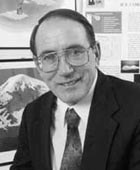Lonnie G. Thompson was awarded the Dr A.H. Heineken Prize for Environmental Sciences 2002 for his pioneering work in research into ice cores in the polar regions and the tropics.
Lonnie Thompson is convinced that ice forms the best archive of the earth’s climate. And that frozen history is located not only at the North and South Poles, but also in the tropics – for example at the peaks of Mt. Kilimanjaro, where the ice caps are in fact melting rapidly. Thompson was one of the first to realise that global warming poses a threat to a number of the world’s ice archives. Partly because of this, gathering data is high on his list of priorities. He has often moved heaven and earth to gain permission to work with his drilling team in a particular location. Under the most extreme conditions, at altitudes where even mountaineers can barely survive, he has succeeded in collecting ice cores. His ice samples come from all over the world: from Bolivia, Peru, China and a host of other locations. The freezers in his laboratory, where Thompson analyses the ice, are now full to overflowing. The information on the climate and the atmosphere which is stored in the ice can go back 700,000 years. The ice contains a clear record of phenomena such as El Niño and the Asian Monsoon, for example; in a somewhat similar way to tree rings, except that the ice history goes much further back in time and contains much more information. Thompson’s research provides an insight into natural climate change, ultimately making it possible to assess the effects of human beings on the earth’s climate, something which has been a source of heated debate among researchers for many years.
Further reading
Thompson, L.G. and Mosley-Thompson E., Microparticle concentration variations linked with climatic change: evidence from polar ice cores. Science212 (1981) 812-815.
Thompson, L.G., Davis M., Mosley-Thompson E., Liu K., Pre-Incan agricultural activity recorded in dust layers in two tropical ice cores. Nature 336 (1988) 763-765.
Thompson, L.G., Yao T., Davis M.E., Henderson K.A., Mosley-Thompson E., Lin P.N., Beer J., Synal H.A., Cole-Dai J., Bolzan J.F., Tropical Climate Instability: The Last Glacial Cycle from a Qinghai-Tibetan Ice Core. Science 276 (1997) 1821-1827.
Thompson, L.G., Davis M.E., Mosley-Thompson E., Sowers T.A., Henderson K.A., Zagorodnov V.S., Lin P.N., Mikhalenko V.N., Campen R.K., Bolzan J.F., Francou B., Cole-Dai J., A 25,000 Year Tropical Climate History from Bolivian Ice Cores. Science 282 (1998) 1858-1864.
Thompson, L.G., Yao T., Thompson E.M., Davis M.E., Henderson K.A., Lin P.N., A high-resolution millennial record of the South Asian monsoon from Himalayan ice cores. Science 289 (2000) 1916-1919.
Biography
Lonnie Thompson was born in 1948 in Huntington, West Virginia and graduated in geology in 1973 from Ohio State University, to which he has remained attached since then. He obtained his doctorate there in 1976 (based on research into micro-particles in ice and the climate), and in 1994 he became a professor in the Department of Geological Sciences. Thompson is also closely involved in the research of the Byrd Polar Research Center at his university. He is very productive, and the results of his research regularly appear in the journals Nature and Science. Thompson also sits on a number of advisory bodies in the field of the climate; he is a member of the editorial team of several journals, a member of a number of international partnerships, and leads one or more research expeditions every year. In 2001 Time Magazine and CNN added his name to the list of ‘America’s Best in Science and Medicine’. Thompson also works hard to ensure that the findings of his research are brought to the attention of politicians and the public at large.
